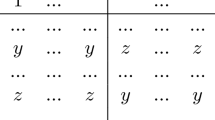Abstract
Public-policy choices frequently have to be carried out in the presence of incommensurabilities. These incommensurabilities may manifest themselves in the form of incompleteness—that is, some of the options under consideration are not comparable by a decision maker. As a consequence, it may be impossible to select policies that are at least as good as all competing proposals. When faced with incommensurabilities of this nature, transitivity can be considered too demanding a requirement. An attractive weakening of transitivity consists of a property that Kotaro Suzumura (Economica, 43:381–390, 1976) introduced under the label of consistency. Suzumura consistency postulates that goodness cycles with at least one instance of betterness are to be avoided thus strengthening the well-known acyclicity condition that precludes the existence of betterness cycles. The property is compared to alternative weakenings of transitivity, and it is shown that it has numerous advantages over other contenders. For instance, Suzumura consistency is precisely what is needed to avoid a money pump. The issue of rational choice in the context of public decision-making is discussed in order to provide an illustration of the usefulness of Suzumura consistency.
Similar content being viewed by others
References
Arrow, K. J. (1951). Social Choice and Individual Values. New York, NY: Wiley.
Bossert, W. (2008). Suzumura consistency. In P. K. Pattanaik, K. Tadenuma, Y. Xu, & N. Yoshihara (Eds.), Rational Choice and Social Welfare: Theory and Applications (pp. 159–179). Berlin: Springer.
Bossert, W. (2018). Suzumura-consistent relations: An overview, international. Journal of Economic Theory, 14, 21–34.
Bossert, W., Sprumont, Y., & Suzumura, K. (2005). Consistent rationalizability. Economica, 72, 185–200.
Bossert, W., & Suzumura, K. (2010). Consistency, Choice, and Rationality. Cambridge, MA: Harvard University Press.
Bossert, W., & Suzumura, K. (2015). Expected utility without full transitivity. Social Choice and Welfare, 45, 707–722.
Chang, R. (1998). Introduction. In R. Chang (Ed.), Incommensurability, Incomparability, and Practical Reason (pp. 1–34). Cambridge, MA: Harvard University Press.
Chang, R. (2013). Incommensurability (and incomparability). In H. LaFollette (Ed.), The International Encyclopedia of Ethics (pp. 2591–2604). Hoboken, NJ: Wiley-Blackwell.
Gibbard, A. (1973). Manipulation of voting schemes: a general result. Econometrica, 41, 587–601.
Hansson, B. (1968). Choice structures and preference relations. Synthese, 18, 443–458.
Hurwicz, L. (1972). On informationally decentralized systems. In R. Radner & C. B. McGuire (Eds.), Decision and Organization: A Volume in Honor of Jacob Marschak (pp. 297–336). Amsterdam: North-Holland.
Raiffa, H. (1968). Decision Analysis: Introductory Lectures on Choices under Uncertainty. Reading, MA: Addison-Wesley.
Richter, M. K. (1966). Revealed preference theory. Econometrica, 41, 1075–1091.
Richter, M. K. (1971). Rational choice. In J. S. Chipman, L. Hurwicz, M. K. Richter, & H. F. Sonnenschein (Eds.), Preferences, Utility, and Demand (pp. 29–58). New York, NY: Harcourt Brace Jovanovich.
Samuelson, P. A. (1938). A note on the pure theory of consumer’s behaviour. Economica, 5, 61–71.
Samuelson, P. A. (1938). A note on the pure theory of consumer’s behaviour: an addendum. Economica, 5, 353–354.
Satterthwaite, M. A. (1975). Strategy-proofness and Arrow’s conditions: Existence and correspondence theorems for voting procedures and social welfare functions. Journal of Economic Theory, 10, 187–217.
Sen, A. K. (1970). Collective Choice and Social Welfare. San Francisco, CA: Holden-Day.
Suzumura, K. (1976). Remarks on the theory of collective choice. Economica, 43, 381–390.
Szpilrajn, E. (1930). Sur l’extension de l’ordre partiel. Fundamenta Mathematicae, 16, 386–389.
Thomson, W. (1990). The consistency principle. In T. Ichiishi, A. Neyman, & Y. Tauman (Eds.), Game Theory and Applications (pp. 187–215). New York, NY: Academic Press.
Funding
No funding to be acknowledged.
Author information
Authors and Affiliations
Corresponding author
Rights and permissions
Springer Nature or its licensor (e.g. a society or other partner) holds exclusive rights to this article under a publishing agreement with the author(s) or other rightsholder(s); author self-archiving of the accepted manuscript version of this article is solely governed by the terms of such publishing agreement and applicable law.
About this article
Cite this article
Bossert, W. Incommensurability and consistency. Philos Stud (2023). https://doi.org/10.1007/s11098-023-02058-7
Accepted:
Published:
DOI: https://doi.org/10.1007/s11098-023-02058-7




